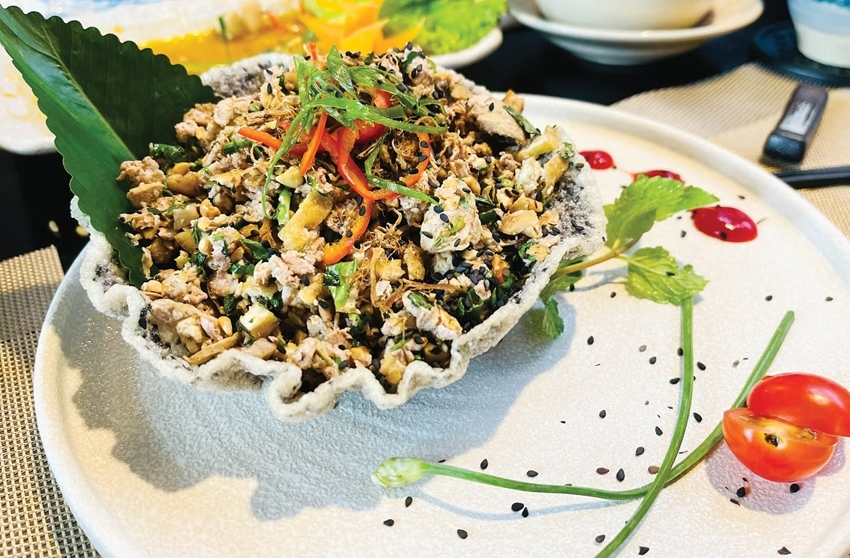 |
| The allure of lotus seed rice. Photo: Bao Minh |
Spreading the good word
Over a decade ago, during a visit to Vietnam, Philip Kotler, the "father of modern marketing", said that Vietnam could become the "kitchen of the world." He was greatly impressed by the diverse and appealing food culture.
Oliver Smith, an American 9X living in Ho Chi Minh City and a lover of Vietnamese cuisine, shared with the media: "Vietnam proudly has an immense culinary treasure. However, for foreigners, accessing information about Vietnamese dishes is quite challenging, as we mainly rely on Google. Currently, there is a lack of an official channel for reference and sharing."
This story is closely related to Hue. Once the Imperial Capital, Thua Thien Hue now preserves many valuable cultural heritages of the nation, including its cuisine, considered as one of the richest and most refined cuisine in Vietnam. Unofficial statistics show that this land has nearly 1,300 dishes of various kinds, from royal meals to common everyday food.
Tourism experts see cuisine as a significant competitive advantage of Hue, being the "Culinary Capital." Against the backdrop of competition among tourist destinations, Hue urgently needs to plan for preserving and promoting its culinary quintessence, transforming its cultural brand into a strong and attractive tourism brand.
 |
| Many vegetarian dishes to be digitized in 3D |
Recently, the Vietnam Culinary Culture Association honored and recognized the value of typical national dishes by awarding certificates to 121 representative dishes in phase I - 2022. Among the 47 dishes from the North, 37 from the Central, and 37 from the South, Hue cuisine contributed six dishes: Hue beef noodles, tapioca dumplings stuffed with roasted pork sweet soup, mussel rice, tapioca dumplings, vegetarian fig salad, vegetarian rice steamed in lotus leaf. In reality, anyone who has tried these dishes cannot deny the deliciousness of Hue cuisine, though many dishes remain unknown to tourists.
Many experts believe that digitizing Vietnamese cuisine will help make these dishes more familiar to international friends. Recognizing the importance of this issue, the Department of Tourism has commenced the digitization of characteristic Hue dishes using 3D technology.
Mr. Nguyen Van Phuc, Director of the Department of Tourism, said that recreating and maintaining Hue's unique dishes, through the cooking of culinary artisans and experts, aims to create an organized and detailed library of these recipes. The purpose of 3D digitization of food is to preserve these characteristic Hue dishes on a 3D technology platform while also developing and promoting Hue's food culture to a wide audience at home and abroad.
Speeding up alongside promotion
According to the Department of Tourism, the 3D digitization process includes scanning the dishes, designing the layout, post-processing, and finally rendering (graphic output) and uploading the data to the system. In 2023, the Department of Tourism will implement the first phase of 3D digitization for dishes categorized into: Royal cuisine with dishes like phoenix-shaped rolls, dragon-shaped fig salad, Pigeon stewed with traditional Chinese herbs; folk cuisine with dishes like roasted pork noodles, Hue-style braised duck, grilled pork skewers, Hue-style summer rolls, mussel rice and noodles, Hue cakes and desserts like banh it (glutinous cakes) with shrimp and pork filling, banh gac, banh bot loc, banh nam, lotus seed sweet soup, tapioca dumplings stuffed with roasted pork sweet soup; and vegetarian dishes including vegetarian noodles, vegetarian lotus rice, vegetarian salad, vegetarian spring rolls.
The Department's leadership emphasizes that through 3D digitization of real spaces, viewers can have a realistic experience, being able to see any point in the space they want, and the presence of each object in that space. The tourism industry hopes that the 3D digitization of characteristic Hue dishes will provide tourists with a comprehensive view of the appearance, structure, and presentation of each dish, thereby, storing detailed information about the dishes in a complete and scientific manner, making it easier to promote these dishes in the future.
Applying digital transformation in preserving and promoting Hue's culinary culture is a correct direction. Besides the dishes mentioned, it is necessary to organize multiple 3D digitization phases of Hue's characteristic dishes in large quantities to preserve, promote, and elevate the culinary culture of Hue in particular and Vietnam in general. After the 3D digitization phases of Hue cuisine, it should be linked with promotional activities to make it known to tourists.
